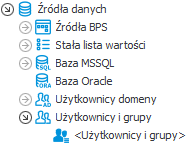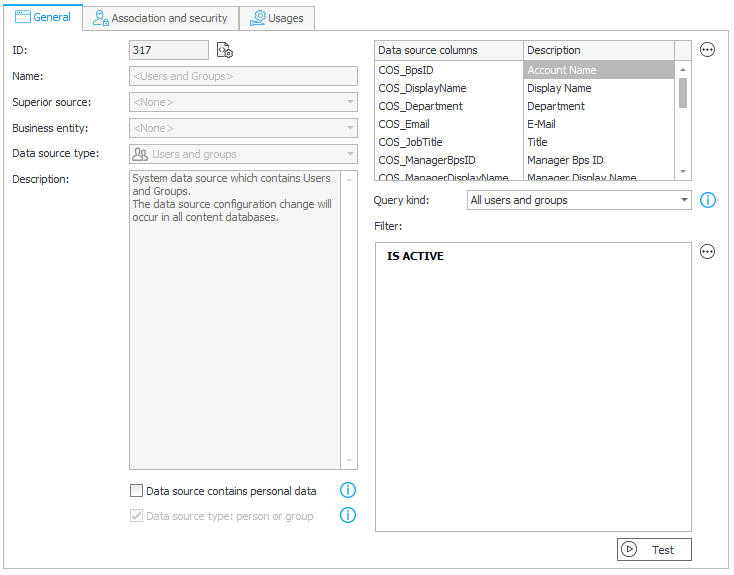Systemowe źródło danych
Wstęp
W wersji 2023 R3, w konfiguracji atrybutu Osoba lub grupa możliwy jest wybór źródła danych i skonfigurowanie filtru po stronie atrybutu (tak jak w przypadku atrybutu Pole wyboru).
Aby nie było konieczne ręczne tworzenie źródeł dla istniejących atrybutów, stworzono systemowe źródło danych o nazwie <Użytkownicy i grupy>, zawierające domyślnie wszystkie (aktywne) elementy z tabeli CacheOrganizationStructure.

Źródło umożliwia filtrowanie listy użytkowników wykorzystywanej w systemie. Celem nowego źródła danych oraz zmian w atrybucie Osoba lub grupa, jest wprowadzenie złożonego filtrowania do obsługi następujących scenariuszy:
- Filtrowanie użytkowników dostępnych w systemie, w przypadku, gdy konfiguracja synchronizacji użytkowników nie pozwala na wskazanie zakresu synchronizacji (np. AAD).
- Umożliwienie wyboru źródła danych w atrybutach Osoba lub grupa, oraz tworzenie źródeł możliwych do wykorzystania przez ten atrybut, tak aby filtrować wartości dostępne w tych atrybutach w różnych miejscach użycia.

Gdzie używane jest globalne źródło <Użytkownicy i grupy>?
Źródło jest domyślnie powiązane z każdą Aplikacją.
Wykorzystywane jest w następujących miejscach:
- Atrybuty Osoba lub grupa
- Kolumny Listy pozycji Użyj źródła danych pola osoby
- Opcja Dowolna osoba w predefiniowanym przypisywaniu zadań
- Delegowanie zadań na Portalu
- Dodawanie uprawnień poprzez akcje administracyjne na Portalu
- Funkcje Reguł biznesowych z węzła “Użytkownicy”, np.: CURRENT USER IS ONE OF, USER IS ONE OF, itd.
- Uprawnienia Globalne, Aplikacji, Procesu, Obiegu
- Opiekun Aplikacji
Uwaga: wszystkie wyżej wymienione obszary korzystają z systemowego źródła <Użytkownicy i grupy>. Ponieważ źródło wykorzystywane jest globalnie, w wielu miejscach, zmiany w jego konfiguracji (filtrze) powinno być odpowiednio przemyślane.
Jeżeli potrzebny jest filtr do specyficznych (miejscowych) zastosowań, np. ograniczenie zwracanych kont w danym procesie, formularzu, lub atrybucie, należy stworzyć osobne dedykowane źródło – klonując systemowe źródło <Użytkownicy i grupy>, tworząc nowe źródło typu Użytkownicy i grupy, lub zdefiniować ten filtr w konfiguracji atrybutu.
Pełna, niefiltrowana lista użytkowników jest wciąż dostępna w następujących miejscach:
- Poglądowo w Synchronizacja użytkowników i grup w Konfiguracji Systemu
- W innych niestandardowych źródłach danych typu Użytkownicy i grupy
Dodano też nowy widok V_CacheOrganizationStructure, zwracający zawartość tabeli CacheOrganizationStructure uwzględniając filtry skonfigurowane na źródle <Użytkownicy i grupy>.
Filtrowanie po stronie źródła danych
Najważniejszym aspektem źródła systemowego <Użytkownicy i grupy> jest możliwość globalnego zdefiniowania filtrów decydujących o wyświetlaniu na listach i użytkowników i grup elementów spełniające określone warunki.
Główne zastosowania filtru to:
- Wykluczenia niektórych kont zsynchronizowanych do cache użytkowników WEBCON BPS (np. konta testowe, konta gości).
- Ograniczenie wartości dostępnych w atrybucie Osoba lub grupa. Np. po dowolnym atrybucie (lokalizacji, stanowisku itd.)
Domyślnie ustawiony został filtr IS ACTIVE – który zwraca konta aktywne (COS_IsActive=1).

Razem z filtrem zdefiniowanym w tym wyrażeniu, stosowany będzie predefiniowany filtr z menu Rodzaj zapytania.
Uwaga: ważne jest, aby filtr nie wykluczył użytkowników nadających uprawnienia, ani administratorów. W przypadku utracenia możliwości zalogowania, należy skorzystać z konta Administratora Lokalnego zdefiniowanego w instalatorze.
Rodzaj zapytania

Predefiniowane filtry stosowane jednocześnie z konfigurowalnymi. Dostępne opcje:
- Wszyscy użytkownicy
- Wszyscy użytkownicy i grupy (opcja domyślna)
Dostępne kolumny

W konfiguracji zwracanych kolumn należy wybrać, które kolumny będą używane przez źródło. Kolumny na szarym tle są wymagane, nie mogą być odznaczone. Są to:
- COS_BpsID*
- COS_Department*
- COS_DisplayName*
- COS_Email*
- COS_JobTitle*
- COS_Login*
- COS_ManagerBpsID
- COS_ManagerDisplayName
Kolumny oznaczone gwiazdką są domyślnie wczytane w konfiguracji każdego atrybutu typu Osoba lub grupa. Pozostałe kolumny mogą być wczytane ręcznie w konfiguracji atrybutu.
Źródło typu: Osoba lub grupa

Dla domyślnego źródła <Użytkownicy i grupy>, ta opcja jest zawsze włączona – nie jest możliwa do wyłączenia.
Parametr decyduje o możliwości wykorzystania źródła w konfiguracji atrybutu o typie Osoba lub grupa oraz kolumny listy pozycji o typie: Użyj źródła danych pola osoby.
Źródło dla którego ta opcja jest zaznaczona, będzie miało wypełnioną ikonę.

Włączenie tej opcji spowoduje, że źródło będzie zawsze zwracać co najmniej 8 kolumn wymienionych powyżej – bez możliwości ich pominięcia.
Zmiany w atrybucie Osoba lub Grupa
Istniejące atrybuty Osoba lub grupa będą korzystać z źródła systemowego <Użytkownicy i grupy>.
Możliwa jest teraz zmiana źródła danych w atrybutach Osoba lub grupa. Źródło musi posiadać typ Użytkownicy i grupy, oraz włączoną opcję Źródło typu: Osoba lub grupa.
Domyślnie załadowanych będzie 6 z 8 kolumn wymienionych powyżej. Dodatkowe kolumny mogą być wczytane w konfiguracji atrybutu.
W zaawansowanej konfiguracji atrybutu wciąż dostępne są dodatkowe filtry w zakładce Picker pozwalające określić Zakres dostępnych danych.
W efekcie, w każdym atrybucie Osoba lub grupa możliwe jest zdefiniowanie filtrów na każdym z wymienionych poziomów, dopasowując miejsce oraz ilość ograniczeń do specyfiki danego procesu oraz organizacji.
- Filtr na poziomie źródła danych <Użytkownicy i grupy> lub Użytkownicy i grupy
- Rodzaj zapytania na poziomie źródła danych <Użytkownicy i grupy> lub Użytkownicy i grupy
- Filtr na poziomie atrybutu Osoba lub grupa
- Zakres dostępnych danych w konfiguracji zaawansowanej atrybutu Osoba lub grupa
================================================================
Applies to version: 2023.1.3 and above
Introduction
This article concerns the system data source <Users and Groups> and its effect on the Person or group form field from 2023 R3 onwards.
The system data source <Users and Groups> (distinguished by the triangle brackets) is meant to act as a filter on top of the list of synchronized users - used to filter away unneeded accounts.

In Person or group form fields, it is now possible to select a data source and configure a filter on the side of the form field (just like it is possible with the Choice field).
So as to not manually create data sources for all existing form fields, the new system data source will be used by default instead.
It contains all (active) elements from the CacheOrganizationStructure table.

Filtering this data source will filter the list of users available all across the system. The goal of creating this new data source and changing the Person or group field is to make it possible to create complex, multi-layer filters to handle the following scenarios:
· Filter users available in the system in situations where the user synchronization configuration does not allow us to define the scope of the synchronization (e.g. AAD).
· Allow data sources to be selected in Person or group fields, and to create data sources that can be used by these fields, so that different filters can be applied in different use cases.
Where is the system data source used?
The data source is associated with all Applications by default.
It is used in the following places:
· Person or group fields
· Item list columns that Use people field data source
· The Any person option in predefined task assignment
· Delegating tasks on Portal
· Adding privileges through admin action on Portal
· Business rule functions in the “Users” node, e.g. CURRENT USER IS ONE OF, USER IS ONE OF, etc.
· Privileges at Global, Application, Process, and Workflow level
· Application supervisor
Note: all areas mentioned above use the system data source. Because this source is used globally and extensively, all changes to its configuration (filter) should be carefully considered.
Suppose a filter is needed for a specific (local) use, e.g. to limit the accounts returned in a specific process, form, or form field. In that case, it is recommended to create a dedicated data source – either by cloning the system data source, creating a new Users and groups source, or configuring the filter at form field level.
The full, unfiltered list of users can still be accessed in the following places:
· An overview can be seen in the Users and groups synchronization in the System settings.
· By creating additional, custom Users and groups data sources and configuring them independently of the system source.
V_CacheOrganizationStructure is a new view that returns the data from the CacheOrganizationStructure table and takes into account any filters defined on the system data source.
Filtering
The core aspect of the new system data source is the ability to define global filters that will limit the users and groups shown across the system. The main purpose of this is to:
· Exclude certain accounts synchronized to the WEBCON BPS users cache (e.g. test accounts, guest accounts).
· Limit the values available in Person or group fields (e.g. according to an attribute like location or position).
The default filter is IS ACTIVE – which returns active accounts (COS_IsActive=1).

This filter will be applied along with the predefined filter from the Query kind option.
Note: it is important for this filter to not exclude people who grant privileges or administrators. If the ability to log in is lost, it will be necessary to use the Local Admin defined in the installer.
Query kind

Predefined filters that are used in conjunction with the custom filter. There are two available options:
· All users
· All users and groups (default option)
Available columns

This area is used to define which columns will be returned by the data source. The columns with a gray background are required and cannot be unchecked.
These are:
· COS_BpsID*
· COS_Department*
· COS_DisplayName*
· COS_Email*
· COS_JobTitle*
· COS_Login*
· COS_ManagerBpsID
· COS_ManagerDisplayName
The columns marked with an asterisk are the default columns loaded into the configuration of each Person or group field. Other columns can be loaded manually in the form field’s configuration.
Data source type: person or group
For the default system data source, this option is always enabled and cannot be disabled.

This option determines whether the data source can be used in a Person or group field or an Item list column that has Use people field data source enabled.
Enabling this option will change the icon of the data source, causing it to be filled.

When enabled, the data source will always return the 8 mandatory columns mentioned above – without any way to skip them.
Changes to Person or group fields
Existing Person or group fields will now use the system data source.
It will now be possible to switch the data source for Person or group fields. Only data sources that are of the Users and groups type and have Data source type: person or group enabled can be selected.
By default, 6 of the 8 columns listed above will be loaded into the field’s configuration.
Other columns can be loaded manually in the form field’s configuration.
The advanced configuration of Person or group fields still contains additional filters in the Picker tab which can be used to modify the Available data range.
In effect, each Person or group field can have filters defined on multiple levels, tailoring the location and specificity of the filters to the given process and organization.
· Filter at or Users and groups data source level
· Query kind at or Users and groups data source level
· Filter at Person or group field level
· Available data range in the advanced configuration of a Person or group field






